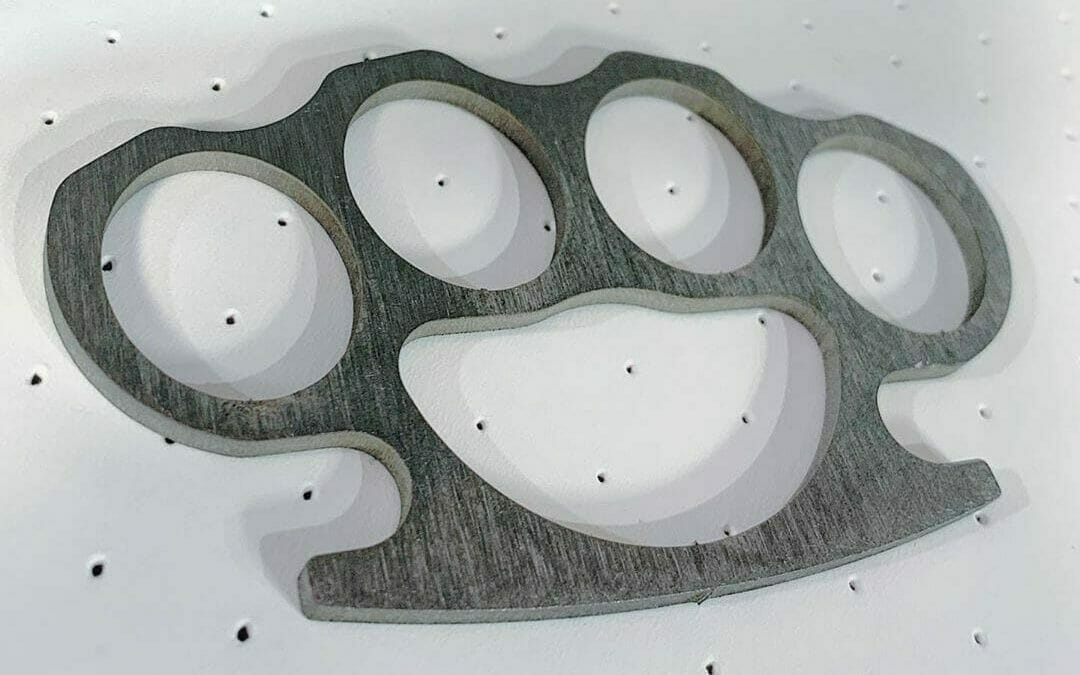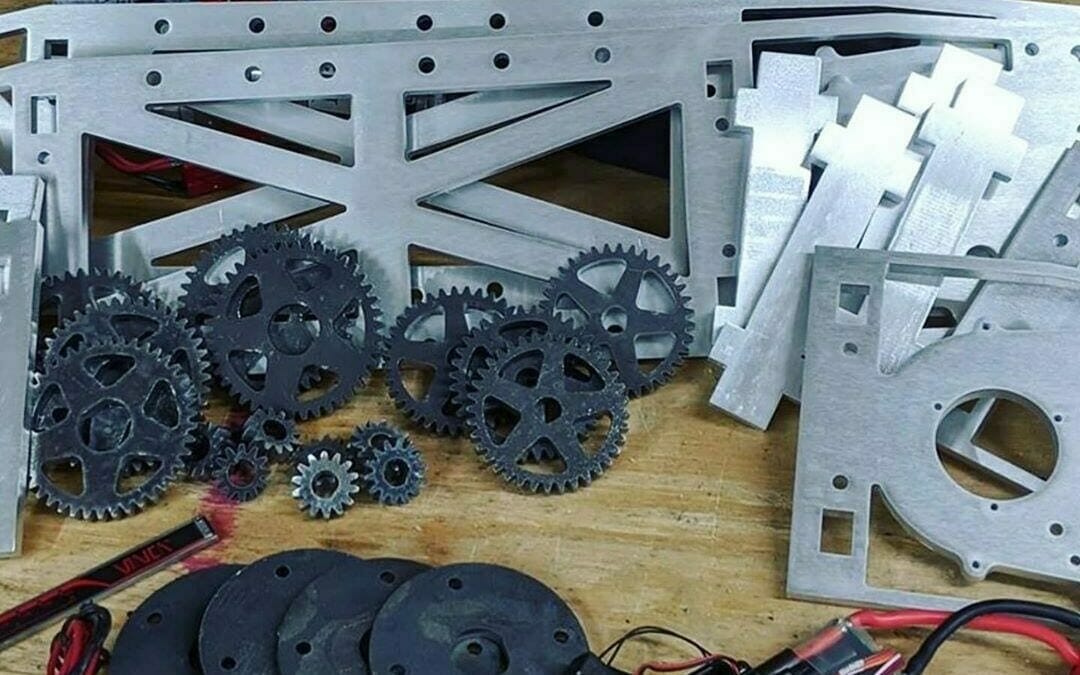One of the strongest lightweight materials available, titanium has a long history of versatility in a huge variety of applications. Here at SendCutSend, we offer both Grade 2 and Grade 5 laser cut titanium to suit all of your high strength project needs. Grade 2 titanium is commercially produced titanium in its purest form, providing your projects with durability, weldability, and elegance. Grade 5 titanium, though not as pure as Grade 2, is actually stronger thanks to the properties of its alloying metals: aluminum, vanadium, and iron. But what specific uses and advantages does titanium bring to your laser cut parts?
Named after the ancient Titans, titanium carries the strength and durability of its celestial namesake. When paired with laser cutting, titanium is one of the highest quality, most versatile materials available for projects of any size. Though it’s higher cost than aluminum or steel (common titanium substitutes), you get better strength, wear and impact resistance, and workability in return. We machine titanium for a huge variety of parts and projects, so keep reading to learn how it can benefit yours!
Twice as Strong, Half the Weight: Properties of Titanium
Titanium is the strongest of the metals that we laser cut, roughly three times as strong as aluminum by weight, twice that of carbon steel, and stronger even than AR500 armor plating. Titanium is also one of the strongest metals available anywhere by weight thanks to its unmatched strength-to-weight ratio. Because of this, titanium is widely used by the aerospace industry in everything from engine and structural components to the skin of the SR-71 Blackbird. It’s also biocompatible and hypoallergenic, making it suitable for use in medical devices, orthopedic implants, and pacemaker parts, as well as applications requiring excellent resistance to seawater and some chemicals.

Sheet titanium has a slight mill scale finish and a light metallic luster, with likely some surface level imperfections from machining. Titanium is well suited for extreme temperature environments and applications, with a melting point of 3000°F. However, pure titanium begins to lose its high strength properties at around 750°F, so if high temperatures are a common concern for your part, be sure to use a titanium alloyed with a more temperature resistant material such as nickel.
Another key characteristic of titanium is its corrosion resistance. The oxide layer which forms on the surface of most titanium alloys when they are exposed to air is one of the most chemically stable and adherent oxide layers found on sheet metal. Titanium, then, is often found on oil rigs and deep sea exploration equipment.
Titanium is surprisingly easy to bend with a little patience. Far more workable than its steel cousins, especially purer forms of titanium sheet metal can be bent, worked, and welded with ease. This workability coupled with its strength-to-weight ratio lends titanium to sports equipment, small and large engine repair, and industrial cookware.
Grades and Forms of Titanium
When discussing all these properties of titanium sheet metal, it’s important to keep its different grades in mind. Each grade of titanium varies greatly in its strength, workability, and temperature resistance. As mentioned above, the two grades of titanium that we offer here at SendCutSend are Grade 2 titanium and Grade 5 titanium. What does that mean? Let’s break it down into each grade’s specific characteristics, similarities, and differences.
Grade 2 titanium is the purest form of titanium offered commercially, so it isn’t alloyed with any other materials. This grade of titanium has less strength than higher grades because of its lack of alloying metals, but it makes up for it in corrosion resistance and workability. As almost pure titanium, Grade 2 is easier to weld and bend. In fact, of the two grades of titanium we offer, we only bend Grade 2 as it experiences less work hardening and allows for more successful forming.
Grade 5 titanium is one of the most common forms of titanium which contains alloying metals. Grade 5 is alloyed with aluminum, vanadium, and iron, increasing its strength exponentially. This is one of the most popular grades of titanium, accounting for almost 50% of global titanium use. Grade 5 titanium is also highly fatigue resistant, allowing it to experience repeated extreme stress and impact without failing. The downside of Grade 5 is its low workability: it cannot be easily bent or formed because of its hardness.
The following chart breaks down some of the most important mechanical properties of these two titanium grades. If you need a refresher on the definitions of these properties, be sure to read through our article on understanding material properties.
| Grade | Tensile Strength | Fatigue Strength | Brinell Hardness | Elasticity | Shear Modulus |
| Grade 2 | 49900 psi | 61600 psi | 200 | 15200 ksi | 6530 ksi |
| Grade 5 | 138000 psi | 74000 psi | 334 | 16500 ksi | 6380 ksi |
The Versatility of Titanium Beyond Strength and Durability
Outside of its huge variety of high strength, industrial applications, titanium is one of the most used metals for aesthetic, lightweight, and elegant applications as well. As the ninth most abundant element found on earth, it’s no wonder that we have found so many uses for titanium.
One of the most common aesthetic applications for titanium is jewelry such as rings and watches. Titanium’s corrosion resistance and hardness allows these accessories to stand the test of daily wear and use, while its silver-white luster and protective titanium dioxide layer provides a beautiful finish that will last for years.
Titanium’s popularity is just beginning to take off too. Described as the “metal of the future,” this element’s natural abundance and relatively untapped potential lends itself to generations more of use and discovery.

What is Titanium Used for? 6 Uses and Industries
Titanium is a material with almost unlimited potential. With its huge variety of uses and benefits, it’s no secret that almost every single industry utilizes titanium in some form. And we believe we still have yet to see the most exciting and innovative applications for titanium come to light! Here are just 6 of the industries where titanium sheet metal is most commonly used:
1. Aerospace
The most well known application for titanium is found in the aerospace industry. From airplane engine parts and external paneling to claiming the title of most used material in most rockets, titanium is highly valued in all facets of aerospace for its unmatched strength-to-weight ratio.
2. Medical
Hypoallergenic and biocompatible, one of the most exciting applications for titanium is in the medical industries. It’s used in standard tools and operating surfaces, but being in an age of biotechnology, titanium is also finding itself in prosthetics, synthetic body parts, and even advancements in neurotechnology.
3. Fashion
Titanium is one of the most aesthetically pleasing metals available, and thanks to its easy workability and wear resistance, it has found its place in the fashion industry. Commonly used in high quality accessories, titanium is also used in more daring statements made by high fashion.
4. Marine
Thanks to titanium’s unbeatable corrosion resistance, the marine industry might be second only to aerospace in its use of titanium. Titanium is also less likely to succumb to the extreme pressures of deep sea exploration, making it an excellent candidate for remotely operated vehicles (ROV) used in these expeditions.
5. Technology
From everyday technology like phones and laptops to the advanced technology used in printed circuit boards (PCBs), titanium is widely used for its conductivity, lightness, and durability.
6. Sports
Sporting equipment uses titanium religiously. Most high quality bike frames are titanium to minimize weight, and equipment such as baseball bats, golf clubs, and rock climbing safety clips also use titanium. This is of course thanks to titanium’s strength, hardness, and fatigue resistance.
What are the Benefits of Using Titanium for Laser Cut Parts?
Titanium has proved itself as one of the most versatile, dependable metals available, but its pairing with our online laser cutting services makes it unbeatable. Titanium is one of the most popular metals we cut, with small and large businesses alike using laser cut titanium in their most successful projects.
Teale Designs is one such business, and many of their Everyday Carry (EDC) tools contain SendCutSend cut titanium. Jeni Elizabeth Jewelry uses titanium for beautiful jewelry pieces, in everything from earrings to bangles. And Precursor Design makes ergonomic, minimalistic wallets with custom laser cut titanium. Check out this list of the benefits of laser cut titanium to see why you should join their ranks:
Improved Edge Quality
All of our parts are precision laser cut using high-purity nitrogen, making for a clean cut with little dross or burr. This helps maintain a strong oxide layer to protect the part as well.
Less Warping
Titanium is less susceptible to warping during laser cutting and handling, unlike other more flexible materials. This means tighter tolerances for your parts and a higher quality final product.
Increased Strength
Of course, we’d be remiss if we didn’t mention the extreme strength of titanium one more time. With high quality laser cutting and careful bending services like ours, your titanium will experience no work hardening, retaining all its strength and losing none of its ductility.
High Accuracy
Our 12kW fiber lasers and perfectly tuned process are capable of achieving the tightest tolerances and highest accuracy on all your laser cut parts. With such a high quality material like titanium, we make sure the machining process matches the needs of the material so you have a near perfect part every time.
Laser cutting titanium couldn’t be easier with our services. Our machining processes raise the bar and are perfectly suited for handling high value material like titanium. We take the utmost care with your designs, so rest assured that your parts and products are in the right hands here at SendCutSend! If you have any questions or concerns about using titanium in your project, check out our article on titanium versus stainless steel. This article breaks down the specific advantages and drawbacks of these two materials which are commonly pitted against each other, and will help you make the right decision for your project.
If you’re ready to place your laser cut titanium order today, simply upload your design to our website and get a quote instantly. If you’re still dreaming up your perfect design, be sure to check out our other articles on all the high quality materials we offer and read through our guidelines to make sure your design will be cut as quickly as possible.





